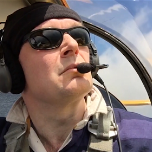Hi Kyle, no they receive the ADS-B tracks (with their GPS) positions, and with the ground station position, they crunch the numbers of range and angle. It’s known as Pilot Aware VECTOR and it’s a free system they are offering people in the UK to check the ranges of their ADS-B, FLARM or P3i (which is a proprietary signal from Pilot Aware devices) installations. It’s a pretty neat system, but it does have a draw back - in that the ground station receivers aren’t a set standard (so they could have 3dB, 5dB, 7dB or even high end 9dB antennae) and it will only report the ranges that you fly from those receivers (so if you only fly 10 miles from a ground station, it will only report 10 miles). So the polar diagram can be very deceptive as it is not showing received strength like a normal diagram, but only the data that has been received - it’s good for the ‘knowns’, but not so good for the ‘unknowns’, if you get what I mean?
Here is a link to their ATOM station - as you can see it is basic Raspberry Pi, SDR and an 1090 MHz antenna: https://global-uploads.webflow.com/5d56c24810fbfdbe08b488cd/5fbfd1a1de7eec471fcb156d_LATEST ATOM GRID installation December 2020.pdf
It’s clever stuff, it is a really benevolent gesture from Pilot Aware, but you have to think carefully about what it is actually showing you.
This is a link to their ATOM VECTOR explanation: https://www.pilotaware.com/analysis/vector
Best, Gaz




